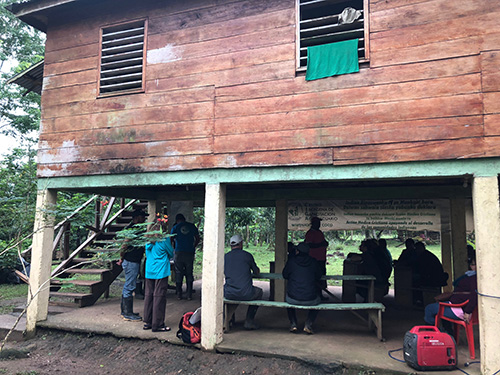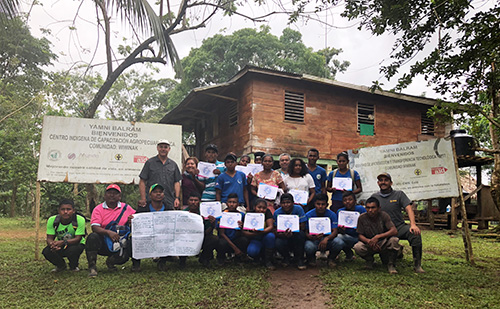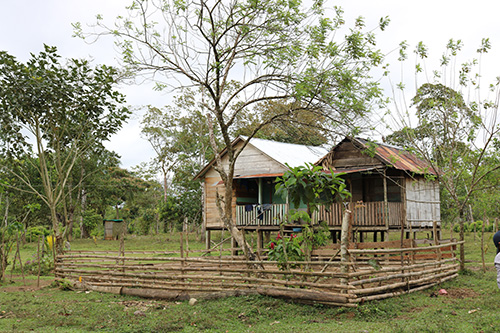
This is the main building at the Wiwinak Center. There is a dormitory space above, and the classroom is downstairs. A separate building houses the kitchen.
The morning fog was just starting to burn off, and dew was still shimmering on the grass. Breakfast preparations were underway, and you could hear shuffling in the dormitory upstairs as people awoke and got ready for the day.
And yet, the group was at it again.
A handful of people were gathered in the classroom at the Wiwinak training center near Nicaragua’s Rio Coco, discussing the finer points of program strategy and methodology on a whiteboard. They had been locked in the same discussions the night before, speaking loudly to be heard over the rumbling generator long after darkness had fallen.
It was a small but diverse group. There was Martin, the Argentina-based regional director of CWS programs in Latin America. Standing across from him were Mark and Denise, Canadians with World Renew who have made Nicaragua their home for 14 and 25 years respectively. Augusto, David and Ishmael from Accion Medica Cristiana – our local partner and one of the most respected organizations in Nicaragua – lent their expertise. My fellow American traveler, Alex from Growing Hope Globally, listened intently.

Caption: Mark (standing, left, with hat) and Martin (kneeling, far right) with graduates from a CWS-supported agricultural certification program. They are in front of the Wiwinak Center.
These discussions weren’t on the schedule. They weren’t a formal part of the visits and meetings that we had done over the previous days. Instead, it was a moment when passionate people were so full of ideas and observations that they couldn’t keep them in any longer. I was humbled to witness this unfolding of partnership as staff from different organizations brought their talents and expertise to strategizing how to most effectively serve the communities in the region.
After spending time visiting this isolated part of Nicaragua and getting to know our work there, I’m convinced that there is no better word to sum it up than this one: partnership.
At every level, this program is rooted on collaboration.
The program’s flagship element is the training center model. Farmers from neighboring communities come to training centers for classes and information sessions. They work together to experiment in ways that will help them all. For example, they may plant three patches of beans using three different techniques. They will take note of how each performs and will use their observations to draw conclusions about what would work best on their own land.

A house in the village of Florida. This resident built a vegetable garden after seeing a neighbor who had participated in the program have success with his garden.
That collaboration spills over into the communities themselves. Each participating farmer agrees to share what he or she learns at the training center with at least two friends and neighbors. As we walked around villages, we saw many houses with beautiful vegetable gardens out front. Some were program participants, and others were simply neighbors who saw the success that a nearby farmer was having and decided to emulate it.
Taking one step back, the partnership between Accion Medica Cristiana and the communities was evident as well. Augusto, David and Ishmael spend three weeks living in the communities at a time before returning to the AMC office in the larger town of Waspam for a week. In the community information sessions, it was obvious that the participants were comfortable with the technicians, and vice versa. This wasn’t someone coming into town to explain how to do things; there was real friendship and respect here.
And finally, looking at the program from the macro level, this program struck me as a textbook example of organizational partnership.
CWS and World Renew both wanted to help meet the needs of the Miskito indigenous communities in this part of Nicaragua, who are facing tremendous challenges. AMC was already at work in this region helping to respond to disasters. Rather than building a new program from scratch, a partnership was born. In conjunction with World Renew and with support from Growing Hope Globally, CWS funds the work of AMC as they address challenges of hunger and malnutrition here. The program unfolds in cooperation with municipal authorities and government agencies, including the Ministry of Health.
On that misty morning, the logos of four different organizations were sprinkled across hats and shirts. But more important than any logo was the unity of purpose I saw on full display. It was a dedicated group hard at work with a single purpose: how to steward resources to reach the most people in the most effective way. That is the CWS partnership model.
Laura Curkendall is the Associate Director of Communications at CWS.
